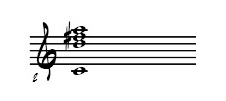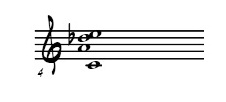Lesson by Camilo Velandia
POLYCHORDS
Polychords (or bichords) are chords constructed of two or more triads. These chords add some harmonic complexity to a chord progression. Although these chords are mostly found in modern classical music and many jazz styles (swing, modern, bossa, etc), they can also be found in pop ballads and a lot of TOP40 tunes (some well-educated arrangers like to be sneaky!).
As you will notice, some of these are more pleasant to the ears than others. Keep in mind that they all serve a different function in whatever tonal system you happen to be in. There are many different polychords, and you can find them on your own. I will give you the polychords I use them most, and the ones I believe are the most useful in today's music (predominantly in jazz) and then I will give you a formula to find your own polychords and a formula to find the scales that work for each one.
For all of these chords, we are going to use the key of C, which has no sharps or flats, so that we can see the contrast.
As you will notice, some of these are more pleasant to the ears than others. Keep in mind that they all serve a different function in whatever tonal system you happen to be in. There are many different polychords, and you can find them on your own. I will give you the polychords I use them most, and the ones I believe are the most useful in today's music (predominantly in jazz) and then I will give you a formula to find your own polychords and a formula to find the scales that work for each one.
For all of these chords, we are going to use the key of C, which has no sharps or flats, so that we can see the contrast.
* MAJOR TRIAD FROM THE b9/ONE CHORD (Phrygian)
This is a very exotic-sounding chord and it fits with the Phrygian mode from the major scale modes. (Visit lesson on major scale modes). It gives a very spanish-like sound. Let's take a look at the major triad from the b9 of C, which would be Db major:
Db MAJOR TRIAD Db F Ab
If we take a look at the Db major triad, we get Db (the b9 from C), F (the 11th), and Ab or G# (the b13th or the #5th). If we take a look at the staff below, we get the following chord:
Db MAJOR TRIAD Db F Ab
If we take a look at the Db major triad, we get Db (the b9 from C), F (the 11th), and Ab or G# (the b13th or the #5th). If we take a look at the staff below, we get the following chord:
This chord makes a great harmonic source for soloing with the C phrygian scale (Ab major). An example of this chord can be found in 6th measure of the tune "Green Dolphin Street".
* MAJOR TRIAD FROM THE 9/ONE CHORD (#11, lydian)
This is a very nice chord to use as a IV chord. It can also be used as a I chord, but be aware that it is going to give you a note that is outside the scale. Let's take a look at the major triad from the 9th (or 2nd) of C, which would be D major:
D MAJOR TRIAD D F# A
If we take a look at the D major triad, we get D (the 9 from C), F# (the #11th), and A(the 13th or the 6th). If we take a look at the staff below, we get the following chord:
D MAJOR TRIAD D F# A
If we take a look at the D major triad, we get D (the 9 from C), F# (the #11th), and A(the 13th or the 6th). If we take a look at the staff below, we get the following chord:
This chord makes a great harmonic source for soloing with the C lydian scale. An example of this chord can be found in 5th measure of the tune "Green Dolphin Street".
* MAJOR TRIAD FROM b7/ONE CHORD (11, sus7)
This is one of the many approaches to playing a dominant chord. It works great as a V chord and also works great to lead into key changes. Let's take a look at the major triad from the b7 from C, which would be Bb major:
Bb MAJOR TRIAD Bb D F
If we take a look at the Bb major triad, we get Bb (the b7 from C), D (the 9th), and F(the 11th). If we take a look at the staff below, we get the following chord:
Bb MAJOR TRIAD Bb D F
If we take a look at the Bb major triad, we get Bb (the b7 from C), D (the 9th), and F(the 11th). If we take a look at the staff below, we get the following chord:
This chord is also known as a C11, or a C7sus. This chord works great with the mixolydian scale.
* MAJOR TRIAD FROM 7/ONE CHORD (dim maj7)
This chord works great as a diminished chord. Whenever you have a song where the melody lands on the major 7th of a major chord, this chord sounds real nice. Let's take a look at the chord from the 7th degree:
B MAJOR TRIAD B D# F#
If we take a look at the B major triad, we get B (the major 7th from C), D# (the #9th or minor 3rd), and F# (the #11th). If we take a look at the staff below, we get the following chord:
B MAJOR TRIAD B D# F#
If we take a look at the B major triad, we get B (the major 7th from C), D# (the #9th or minor 3rd), and F# (the #11th). If we take a look at the staff below, we get the following chord:
This chord sounds very beautiful when it is substituted for, or followed by a major 7. For example, in Bill Evan's tune "Spring Is Here". To solo over this chord, you can use the C diminished whole-half scale.
* MAJOR TRIAD FROM THE 6/ONE CHORD (13b9)
A very common polychord is the one constructed with the major triad of the VI chord over the triad of the I chord. If we take the A major triad, we get the following:
A MAJOR TRIAD A C# E
If we take a look at the A triad above, we have A (the 13th from C), C# or Db (the b9 from C) and E (the 3rd). Now, in order to have our poly chord, we need to add some kind of a C chord in the bottom. If we add a C7 under the A major triad, we get the following:
A MAJOR TRIAD A C# E
If we take a look at the A triad above, we have A (the 13th from C), C# or Db (the b9 from C) and E (the 3rd). Now, in order to have our poly chord, we need to add some kind of a C chord in the bottom. If we add a C7 under the A major triad, we get the following:
This chord can easily be the V chord to anything. Because it has a natural 13th, it gives you a diminished sound, as opposed to a b13 like a 7#5 chord. To solo over this chord, you can use the diminished half-whole scale starting from C. C super locrian or altered scale wouldn't work over this the chord has a natural 13th.
* MAJOR TRIAD FROM THE TRITONE/ONE CHORD (7b9b5)
This is a very common polychord in bossanova and other brazilian music, and most importantly, one of my favorites! (hehe) This chord has a pretty outside sound for a dominant chord so use it wisely. Let's take a look at the chord from the tritone of C, which is F# major:
F# MAJOR TRIAD F# A# C#
If we take a look at the F# triad above, we have F#, (the #11 from C), A# or Bb (the b7) and C# or Db (the b9). This chord gives you a few real good alterations to work with. If we add a C7 under the F# major triad, we get the following:
F# MAJOR TRIAD F# A# C#
If we take a look at the F# triad above, we have F#, (the #11 from C), A# or Bb (the b7) and C# or Db (the b9). This chord gives you a few real good alterations to work with. If we add a C7 under the F# major triad, we get the following:
This is a GREAT sounding V chord. It works great over bossa novas, etc. Resolving the #11 from the V chord to the 9 of the I chord makes a good resolution. For example:
| C7b9b5 | C7b9b5 | Fmaj9 | Fmaj9 |
| C7b9b5 | C7b9b5 | Fmaj9 | Fmaj9 |
* MAJOR TRIAD FROM THE 3rd/ONE CHORD (maj7#5)
This is a very modern sounding chord. This chord has a real outside sound, and although it can be used as a I chord temporarily, it is VERY important to be aware of it's sound. I wouldn't recommend playing a happy tune with this chord as the I chord. Let's take a look at the chord from 3rd of C, which is E major:
E MAJOR TRIAD E G# B
If we take a look at the E major triad above, we have E, (the 3rd from C), G# or Bb (the b7) and C# or Db (the b9). Playing around this chord can give some real nice outside sounding melodies. Let's take a look at the chord:
E MAJOR TRIAD E G# B
If we take a look at the E major triad above, we have E, (the 3rd from C), G# or Bb (the b7) and C# or Db (the b9). Playing around this chord can give some real nice outside sounding melodies. Let's take a look at the chord:
To come up with your own polychords, first find the root you want to use. Then a good way to start, is to play a random triad under that root and then analyze it. What degrees are the notes from the triad in comparison from the root? Experiment with major triads, minor triads, and even dominant triads. Many triads will just simply be other chords. For example, an Eb triad over the root of C is just simply a C minor 7. Then, to take it one step further, aside from adding a triad on top, alter the third or the seventh of the root. If there was anything very confusing about this lesson, you can always message me with questions by clicking here. Best of luck!?
-CV









